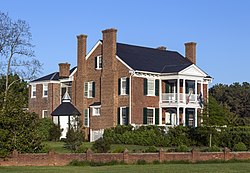Cuckoo (Mineral, Virginia)
Cuckoo is a Federal style house in the small unincorporated area Cuckoo, Virginia near Mineral, Virginia. The house was built in 1819 for Henry Pendleton. On August 19, 1994, Cuckoo was added to the list of National Register of Historic Places.[1] The house is near the U.S. Route 33, which curves around the house. Cuckoo has Federal details and Colonial Revival elements from the early 20th century. The house is known for its design, prominence and its association with the Pendleton family of doctors. The house was named for the Cuckoo Tavern. The Pendleton family owns the house since its construction.[3]
Cuckoo | |
 Cuckoo in 2015 | |
| Location | Jct. of US 33 and VA 522 S, near Mineral, Virginia |
|---|---|
| Coordinates | 37°57′11.51″N 77°53′59.69″W / 37.9531972°N 77.8999139°W |
| Area | 47.1 acres (19.1 ha) |
| Built | 1819 |
| Architectural style | Colonial Revival, Federal |
| NRHP reference No. | 94000550[1] |
| VLR No. | 054-0016 |
| Significant dates | |
| Added to NRHP | August 19, 1994 |
| Designated VLR | April 20, 1994[2] |
History
changeThe first construction had a two storied front section with a one-story extension to the rear. The dining room and the winter kitchen were in the one-story section. Between 1839 and 1907 the house was owned by Dr. Philip Barbour Pendleton. He added a second floor to the rear part of the house and extended the main roof to cover the new rooms of the house. A later generation of Pendletons rebuilt the house in the Colonial Revival style after 1910. They added the present Neoclassical portico. The next owners, Anne Pendleton Forrest and Dr. William Mentzel Forrest, added to the back a design by architect Stanislaw J. Makielski of Charlottesville. The complex includes a number of outbuildings, including two separate doctor's office buildings, a garage, barn, a house for smoking, and the Pendleton family cemetery.[3]
Description
changeCuckoo is a house made of bricks. It has two floors and a center-hall which is divided into three parts. Single rooms are flanking the stair hall. The house has a porch on its entire front. A semicircular closet with a small window is between the fireplaces of the rooms to the right of the center hall. The fireplaces and chimneys are on both sides of the elevation. The Makielski addition to the back of the house has a porch that echoes the curve of the closet. The addition includes a back stairway.[3]
Outbuildings
changeThe small doctor's office was probably built in the early-to-mid 19th century for Dr. Robert Barret. It is to the north of Cuckoo, and was moved to Cuckoo by Dr. Philip Barbour Pendleton before the American Civil War. The large doctor's office was built around 1888 for Dr. Eugene Pendleton. It was expanded to also include his son's practice around 1908. It was moved to Cuckoo in 1910 when Eugene moved there. The office was moved again in 1972 when the highway was built, and was used as a medical office by Dr. Eugene Barbour Pendleton until 1979. A house for smoking was built in the late 19th century, and a barn in the early 20th century. A garage was built in the 1930s.[3]
Cemetery
changeThe Pendleton cemetery is in an oak grove at the top of a small rise about 1/4 mile from the house. It is surrounded by a low stone wall. The cemetery has three gravestones and several unmarked graves.[3]
Recent history
changeCuckoo was listed on the National Register of Historic Places on August 19, 1994.[1] The house was damaged in the 2011 Virginia earthquake. The tall chimneys broke down.[4]
References
change- ↑ 1.0 1.1 1.2 "National Register Information System". National Register of Historic Places. National Park Service. 2010-07-09.
- ↑ "Virginia Landmarks Register". Virginia Department of Historic Resources. Retrieved 5 June 2013.
- ↑ 3.0 3.1 3.2 3.3 3.4 Neville, Ashley M. (March 1, 1994). "National Register of Historic Places Registration Form: Cuckoo" (PDF). National Park Service. Retrieved August 25, 2011.
- ↑ "Virginia Earthquake". Richmond Times-Dispatch. August 23, 2011. Archived from the original on February 4, 2013. Retrieved August 31, 2011.

